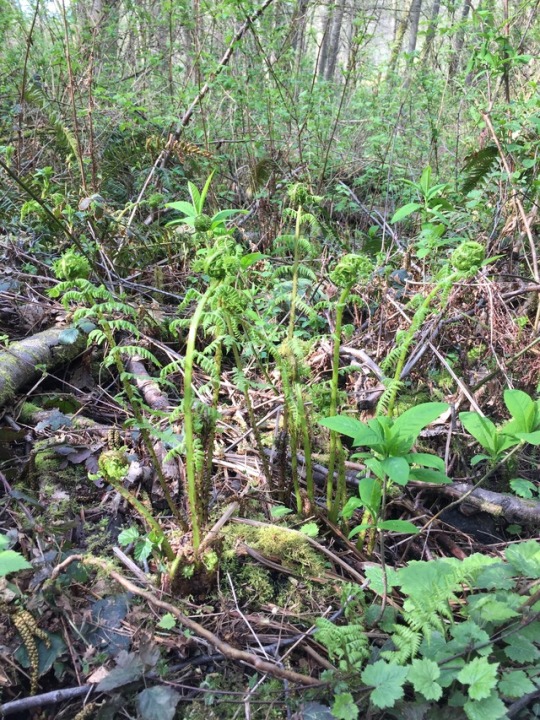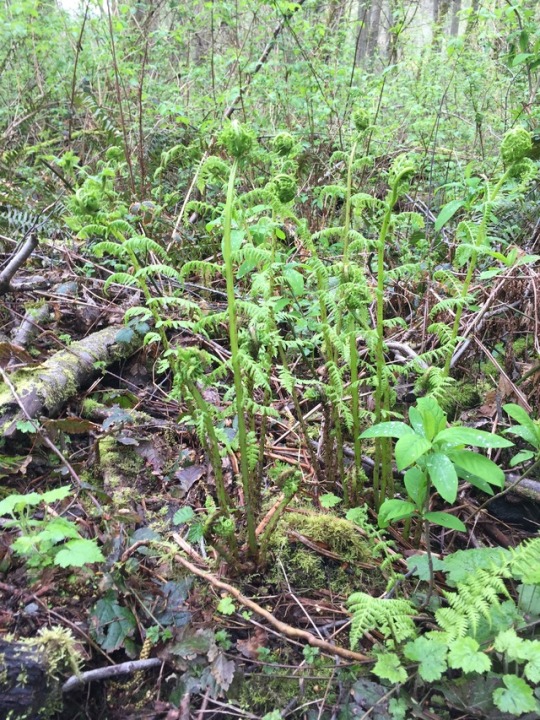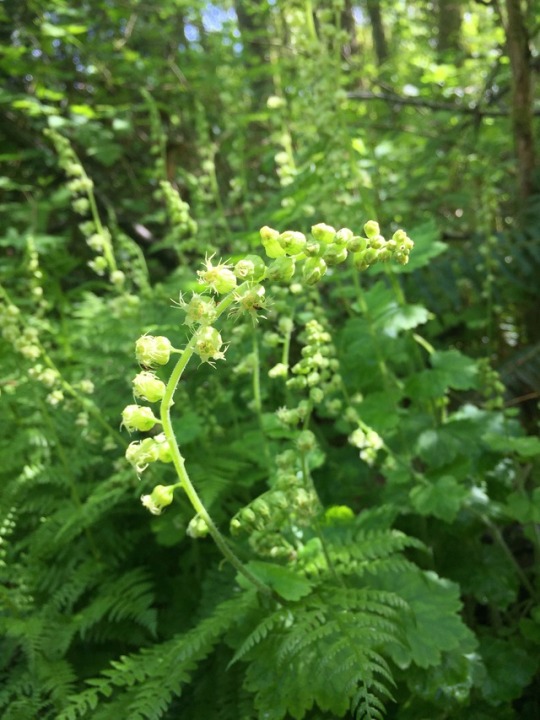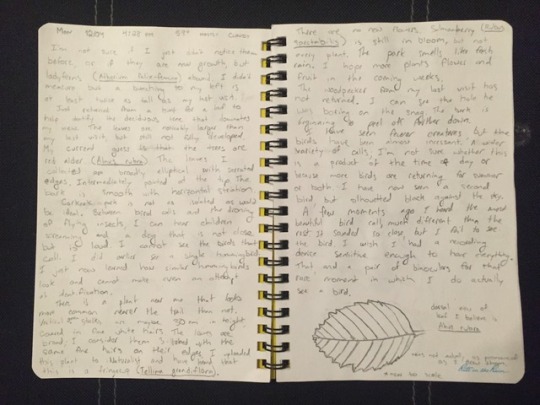#atherium filix-femina
Photo


The same patch of ladyfern (Atherium filix-femina)
4 notes
·
View notes
Text
SATURDAY 22/04
7:04 PM
55º, sunny
It’s been about a week and a half since I was at Carkeek Park last. This patch of ladyferns (Atherium filix-femina) just off the trail is almost fully grown. They’re maybe a metre high. Behind the ladyferns is an Indian-plum (Oemleria cerasiformis) I hadn’t noticed. You can see this plant in previous pictures of this site, so apparently I’m just oblivious. The fringecups (Tellima grandiflora) are recognizable to me, now. The cups themselves have... emerged? The plants were just the leaves before. I don’t know if the cups actually bloom, but some of them are still furled. Nothing new besides has bloomed.
These trees that I think are alders (Alnus), I still think they’re alders. Their leaves are at least twice as big as they were when I was here last. Additionally, there are alder cones all over this area.
[EDIT: After I left, I began second-guessing myself again. The trunks are tall and generally straight with only small branches closer to the top, but the trunks aren’t covered in the lichen spots characteristic of alders.]
There is what I believe to be a young maple, presumably a big leaf maple (Acer macrophyllum) across from the ladyfern patch. The leaves probably aren’t larger than the palm of my hand yet, but large enough to determine the tree is a maple (or at least not an alder).
The birds are screaming. All of them. Non-stop. I don’t recognize any calls. [At least] Two of the birds were screaming calling in response to each other. I presume they were delineating territories.
1 note
·
View note
Photo






Stop 6: Plants
Continue along Hillside Trail. At the first fork, stay to the right. At the second, to the left. You will come upon two sections of stairs. Climb the first section to the small landing, then only to the 4th step of the second set. This is the location to which I returned almost weekly to document the changing landscape. Just behind you to the north (your right) is the ladyfern patch (Atherium filix-femina) I watched grow over the course of my observations. The ground-cover plant next to the ferns, with pointed, five-lobed leaves are Pacific water-leafs (Hydrophyllum tenuipes). If you turn around, the round-lobed ground-cover you’ll see on the other side of the trail are fringecups (Tellima grandiflora). Amidst the fringecups are taller stalks with three-lobed, pointed leaves. These are the large-leaved avens (Geum macrophyllum). Behind the fringecups and avens, you can see two large shrubs with three serrated leaves in clusters, and if you cover the distal leaf, the remaining two leaves look like butterfly wings. This shrub is salmonberry (Rubus spectabilis). If you turn around again, back to the side with the ladyfern patch, the large shrub behind the waterleafs, with the broad, soft, five-lobed leaves is a thimbleberry plant (Rubus parviflorus).
The most common tree you can see in this spot is the alder (Alnus sp.), but there are two western red cedars (Thuja plicata) and a big-leaf maple (Acer macrophyllum). Near the ladyfern patch is an Indian-plum (Oemleria sp.). For more information on the plants around you and how to identify them, please click the “Journal” link at the head of my blog.
0 notes
Text
WEDNESDAY 24/05
4:46 PM
57º, mostly cloudy

[ABOVE: thimbleberry flowers]
The fringecups (Tellima grandiflora) are beginning to wilt. There are significantly fewer flowers than my previous time here. Also, the plant I believe to be angled bitter-cress (Cardamine angulata) no longer has flowers. The thimbleberry plant (Rubus parviflorus), however, has many bloomed flowers, with less than half the original buds yet to open. I believe my identification of Pacific waterleaf (Hydrophyllum tenuipes) from my last visit is correct. This plant is almost in full bloom. I spot only a small handful of buds still to open. The large-leaved avens (Geum macrophyllum) flowers are beginning to be replaced by the fruits of this plant, green spherical achenes covered with white-ish hairs. The ladyfern (Atherium filix-femina) patch I have admired from its infancy is now the height of my chin, and I believe it to be fully grown. So, too, I believe, are the leaves of the maple (Acer macrophyllum) just to my right. I used to be able to see much more of the sky from my location, now light enters only from large gaps between trees. I notice now one alder (Alnus sp.) clinging to life. The top of the tree no longer bears leaves, only a handful of lower branches hold green. I do not see any other new plants or noticeable changes.
[BELOW: Pacific waterleaf flowers; large-leaved avens flowers]


Something just... fell? Out of a tree? I heard branches cracking and a dull, very heavy thud to my left. No other noise from that direction.
Crows dominate the bird calls today. I hear few songbirds, and those I do hear are much in the distance.
Not at my exact location, but elsewhere in the park, I have found a ripe orange salmonberry (Rubus spectabilis). Two, in fact.
Today I learned (I already knew this) that I cannot draw without reference pictures. Get ready for poorly drawn and disproportionate birds. Also, my eraser and journal don’t get along well, so everything has weird smudges.
0 notes
Text
WEDNESDAY 10/05
3:55 PM
72º, sunny
Dear Diary,
Today I hecked and left my field journal at home [so I transferred my notes later]. Whoops. Anyway, I’m glad it’s not raining and I can use a regular notebook. Also, I had no idea how rocky the trail is until I decided to hike without shoes. I think I just heard a song sparrow, or whatever bird we talked about the calls in lecture the other day.
The salmonberry (Rubus spectabilis) flowers are essentially gone, having given way to young fruits. The fringecups (Tellima grandiflora) have, I assume, attained full height, as they do not look vastly different from a week ago. There are, however, many more stalks with cups, and some cups have pink or red on their rims. The ladyfern (Atherium filix-femina) patch is still growing, the tallest leaves reaching my armpits. The plant I attempted to identify last week now has flowers and is certainly a thimbleberry bush (Rubus parviflorus). The hairs on the stalks and leaves that concerned me last week are less prominent, and the leaves are very soft. There are two other plants near me that have bloomed flowers. One of them I believe to be a species of mustard, my current guess being angled bitter-cress (Cardamine angulata). Very small white flowers are beginning to bloom, with four petals each. These flowers are at the ends of stalks that are at most 30cm tall, with roughly 20 silique growing alternating down the stalk until the leaves. The leaves themselves have seven leaflets with small lobes usually on the side of the leaflet closer to the main stalk. The other species freshly in bloom are large-leaved avens (Geum macrophyllum). They only have one to three flowers per plant currently, but many unopened buds.
I guess I lied; there is one more plant with flowers right now. I drew one of the leaves of this plant a few weeks ago, but it was a contour sketch, so you can’t really tell. This plant has the leaf structure of a Pacific waterleaf (Hydrophyllum tenuipes), but the flowers are too young for me to make a positive ID.
The alder (Alnus rubra) leaves are presumably fully grown at this point. The maple (Acer macrophyllum) still has many smaller leaves, so I assume the leaves of this tree are not done growing.
I’m pretty sure every time I come here, there is precisely one dog barking in the distance for an extended period of time.
So earlier I drew one bee [see later post] and now I see four bees. They all kind of look the same from this distance, so I’m not going to draw them again. They’re flying around this patch of Pacific waterleaf from flower to flower. Occasionally, they’ll find a flower that pleases them and land. They moved fairly methodically across this patch, generally right to left from my view.
0 notes
Photo

MONDAY 12/04
4:28 PM
59º, mostly cloudy
I’m not sure if I just didn’t notice them before, or if they are new growth, but ladyfern (Atherium filix-femina) abound. I didn’t measure, but a bunching to my left is at least twice as tall as my last visit.
Just returned from a hunt for a leaf to help identify the deciduous tree that dominates my view. The leaves are noticeably larger than my last visit, but still not fully developed. My current guess is that the trees are red alter (Alnus rubra). The leaves I collected are broadly elliptical with serrated edges. Intermediately pointed at the tip. The bark is smooth with horizontal striation.
Carkeek Park is not as isolated as would be ideal. Between bird calls and the droning of flying insects, I can hear children screaming and a dog that is not close but is loud. I cannot see the birds that call. I did earlier see a single hummingbird. I just now learned how similar hummingbirds look and cannot make even an attempt at identification.
There is a plant near me that looks more common nearer the trail than not. Vertical green stalks are maybe 30 cm in height. Covered in fine white hairs. The leaves are broad; I consider them 3-lobed with the same fine hairs on their edges. I uploaded this plant to iNaturalist and have heard that this is a fringecup (Tellima grandiflora).
There are no new flowers. Salmonberry (Rubus spectabilis) is still in bloom, but not every plant. The park smells like fresh rain. I hope more plants flower and fruit in the coming weeks.
The woodpecker from my last visit has not returned. I can see the hole he was boring on the snag. The bark is beginning to peel off further down.
I have seen fewer creatures, but the birds have been almost incessant. A wider variety of calls; I’m not sure whether this is a product of the time of day or because more birds are returning for summer or both. I have now seen a second bird, but silhouetted black against the sky.
A few moments ago I heard the most beautiful bird call, much different than the rest. It sounded so close, but I fail to see the bird. I wish I had a recording device sensitive enough to hear everything. That, and a pair of binoculars for that rare moment in which I do actually see a bird.
#journal#puget sound region#pacific northwest#animal#plants#natural history#carkeek park#washington state
0 notes